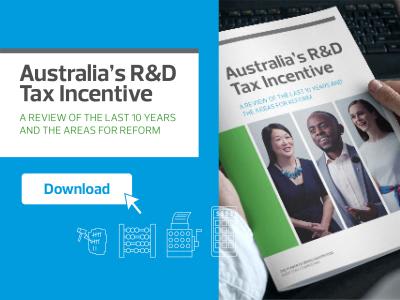R&D Tax Incentive Expert Consultants
Are you an entrepreneur, business owner or C Suite management that strives for innovation through R&D?
The Research and Development Tax Incentive (RDTI), is a government-backed reward program for companies that incur research and development (R&D) costs.
R&D can be an uncertain and expensive undertaking, particularly for small businesses and entrepreneurs who may have limited resources and financial support.
The RDTI can give your Australian business up to 43.5% cash back for most companies (or up to 48.5% in limited circumstances) to help mitigate some of this risk and cost.
Many companies are unaware of the RDTI and the financial benefits it provides. Others simply do not have the in-house capabilities or time to make a claim or could be unaware of the risk involved with non compliance with the RDTI legislation if self-claiming or using inexperienced advisors.
This is where RSM’s Melbourne based R&D Tax Incentive specialists can assist.

DID YOU KNOW?
The size of the R&D offset is determined by the entity's aggregated turnover.
UNDER $20 MILLION AGGREGATED TURNOVER
Entitles the entity to a refundable R&D tax offset calculated as tax rate + 18.5%. This equals 43.5% for companies on a 25% corporate tax rate. This means profitable entities pay less tax and entities making a loss will get a cash refund.
OVER $20 MILLION AGGREGATED TURNOVER
Entitles the entity to a non-refundable R&D tax offset that can reduce its tax liability or be carried forward to future periods. Depending on your ‘R&D intensity’, the incremental R&D benefit range from 8.5% to 16.5%.

RDTI commonly asked questions:
Our RDTI advisers have extensive experience in successfully preparing applications and obtaining RDTI benefits for activities undertaken to acquire new knowledge; or information in relation to new or improved materials, products, devices, processes or services.
Here is a few commonly asked questions to get you started:
A company must register its R&D activities with AusIndustry within 10 months after financial year end and provide details on its R&D expenditure (along with the registration number provided by AusIndustry) in an R&D Tax Incentive Schedule which is lodged with the company’s Income Tax Return. A company can only receive its RDTI benefit once both these steps are undertaken.
As the program is a self assessed entitlement program, RSM recommends that you have experienced RDTI advisors assisting with the assessment of the eligibility of your activities and expenditure, as getting it wrong can put you at risk of having to pay back benefits received plus penalties and interest.
If you are conducting eligible R&D activities in any industry, you may be entitled to claim an R&D tax offset under the RDTI
The RDTI is broad-based support across industries that conduct activities based on principles of established science, however, there are some industries which may not meet the eligibility criteria and there are exclusions. As long as a company (in any industry) meets the RDTI eligibility criteria, then it can claim the RDTI.
To assess whether the activities you are conducting, qualify for a claim under the RDTI and an estimated benefit, we have set out 6 simple steps.
Common industries claiming the RDTI include technology / software, mining and resources, manufacturing and engineering, and life sciences.
Eligible R&D activities are defined in the legislation that underpins the program. Division 355 of the Income Tax Assessment Act 1997 identifies eligible activities as either core R&D activities or supporting R&D activities.
Core R&D activities
Core R&D activities are experimental activities:
Whose outcome cannot be known or determined in advance on the basis of current knowledge, information or experience, but can only be determined by applying a systematic progression of work that:
is based on principles of established science; and
proceeds from hypothesis to experiment, observation and evaluation, and leads to logical conclusions; and
That are conducted for the purpose of generating new knowledge (including new knowledge in the form of new or improved materials, products, devices, processes or services).
Supporting R&D activities
Supporting R&D activities are activities directly related to* core R&D activities.
Projects are usually made up of one or more activities. When identifying R&D activities for the RDTI, it’s imperative to focus on the individual activities that involve R&D and not the entire project.
The RDTI is a Tax Offset between 18.5% to 43.5%, depending on your turnover and profitability as outlined below.
Aggregated turnover of less than $20 million
For R&D entities with aggregated turnover of less than $20 million, the refundable R&D tax offset is your corporate tax rate plus an 18.5% premium. This equals 43.5% for most companies (and 48.5% for non base rate companies)
This means profitable entities pay less tax and entities making a loss will get a cash refund.
Aggregated turnover of $20 million or more
For R&D entities with aggregated turnover of $20 million or more, the non-refundable R&D tax offset is your corporate tax rate plus an incremental premium which reduces the company’s tax liability or can be carried forward to future periods.
The premium increments are based on your R&D Intensity. This is a percentage of your eligible R&D expenditure as proportion of your total expenditure for the year.
All eligible R&D expenditure up to 2% R&D Intensity will receive a non-refundable R&D tax offset equal to your corporate tax rate plus 8.5% premium.
Additional eligible R&D expenditure above 2% R&D Intensity will receive a non-refundable R&D tax offset of your corporate tax rate plus 16.5% premium.
Therefore the R&D Tax Offset ranges from 33.5% to 46.5%, equating to a permanent after tax cash benefit of 8.5%-16.5% of the R&D expenditure.










